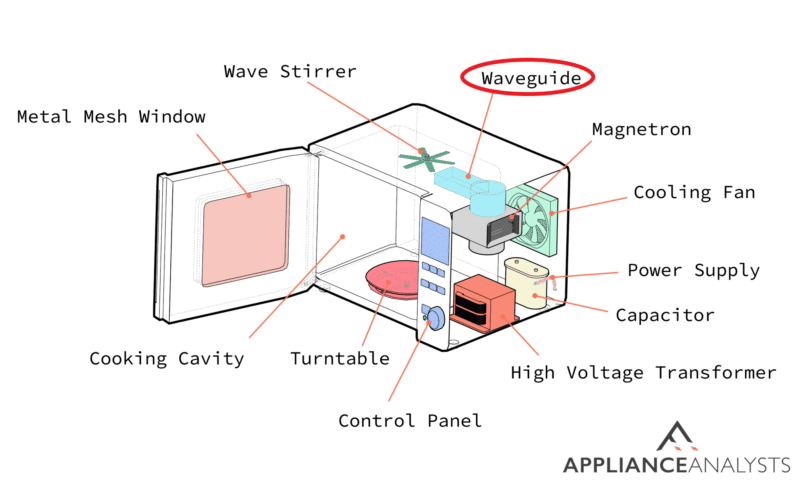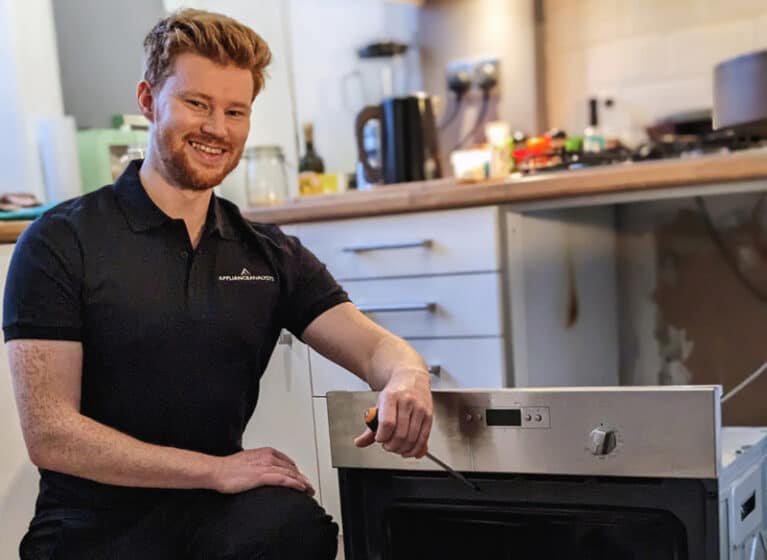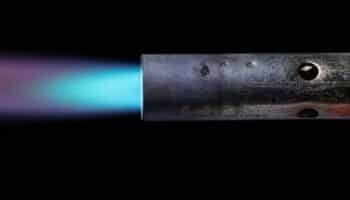We've independently reviewed this article to make sure it's as accurate as we can make it.
To find out more about our article creation and review process, check out our editorial guidelines.
Stuck trying to figure out why your microwave is sparking?
Don’t worry; I’ve been there too. There’s nothing quite as alarming as trying to reheat leftovers in the microwave and seeing sparks instead.
Luckily, you can quickly fix some microwaving sparking problems yourself.
If your microwave is sparking, turn it off immediately and inspect the interior to identify the cause of the issue. There’s a good chance you accidentally left metal or grapes inside, the waveguide cover is broken, or it has a faulty diode.
Read on to learn how to solve the problem!
Why trust us? This article was written by Craig Anderson and James Blackford.
Craig has helped thousands of other homeowners repair their appliances since 2016.
James is one of our resident appliance experts, with over 16 years of experience. He currently works as a Master Technician for SquareTrade, and runs his own appliance repair business.
Prefer to Listen?
If you prefer video or audio, here’s me and James talking about dealing with a sparking microwave for the ApplianceAnalysts Podcast:
5 Reasons Your Microwave Is Sparking
Unlike traditional ovens, which work through convection, microwave ovens heat food through electromagnetic waves, known as microwaves.
Most of the time, these are perfectly safe. However, in certain situations, these electromagnetic waves can turn into electricity. That’s when you start getting sparks in the microwave.
Luckily, there are only a few reasons why electromagnetic waves would turn to electricity and cause sparks. Here are some of them:
#1 Worn Out Paint
Worn-out paint is one of the most common explanations for your microwave sparking.
I know it can be very confusing to have your microwave sparking without metal inside it, but that’s exactly the thing – there is metal inside it. In fact, the entire appliance’s internal compartment is made out of it.
So, why isn’t there always sparking? Great question!
Some microwaves have small plastic clips on the inside to place additional racks. Over time, grease buildup can eat away the paint behind the clips and expose the metal. Once the metal is exposed, the electromagnetic waves in your microwave find ground in the areas with missing paint and produce electricity.
Luckily, fixing worn-out paint is very easy. In my experience, marketplaces like Amazon and eBay are great places to find special microwave paint that you can use to cover the exposed areas of your microwave. The special microwave paint can cost anywhere between $5-$10 and will last a long time.
Repainting the exposed areas should keep your microwave from sparking again.
#2 Metal in the Microwave
Never put metal in the microwave! Metal and electromagnetic waves don’t get along well.
When metal goes into the microwave, it creates many sparks. The electromagnetic waves get turned back into electricity, causing a serious light show.
If your microwave is sparking when it runs, the most likely reason is that there’s metal inside. You may have left your spoon in your coffee or some tin foil on your leftovers. Even a small scrap of steel wool left after cleaning can lead to sparking.
Note: If your microwave is sparking after cleaning, please avoid using steel wool. Instead, opt for soft cloths or sponges.
#3 Broken Waveguide Cover
If your microwave is sparking without metal, you’ll want to keep reading.
When the unit makes the microwaves that cook your food, it projects them through a little panel known as a waveguide. When the waveguide cover is broken, your microwave is in trouble.
The waveguide cover is in place to protect the electronics in the microwave oven. Steam and food particles can build up in the electronics with a broken waveguide cover.
If you notice sparking coming from a panel in your microwave, a broken waveguide cover is probably the cause.

#4 Faulty Diode
Faulty diodes are the least likely reason that your microwave is sparking, but they’re also the worst.
Your microwave uses diodes to create waves and cook your food. If you have one or more faulty diodes, you’ll start to see sparks. Your microwave will probably stop working shortly afterward, too.
#5 Grapes
Yes, grapes can cause your microwave to spark! However, if that’s the case, you probably did it intentionally. And while there’s nothing wrong with being curious, you must be very careful.
Cutting a grape nearly in half and then microwaving it can cause plasma and balls of light to form in your microwave.
Placing cut grapes in your microwave can damage it, so I don’t recommend trying this with a unit you want to use in the future.
How to Fix a Sparking Microwave: 4 Simple Steps
To fix a sparking microwave, you must first figure out the problem. Here are four steps to stopping a sparking microwave every time.
- Turn off the microwave immediately. If the sparks were extremely bright or seemed to come from the microwave’s walls, unplug it to turn it off. You don’t want to risk electrocution!
- Check to see whether you put any metal in the microwave. If you left cutlery inside or used a metal dish or tin foil, that was probably the cause. Remove it, and you should be all set.
- If there’s no metal in the microwave, check the waveguide cover. The waveguide cover is a small panel on the inside of the thicker side of the microwave. If it looks cracked or damaged, the sparks are probably the cause. I recommend ordering a replacement waveguide and then unplugging your microwave to replace it. With some cheap microwaves, it’s simpler to get a new unit. More expensive models might be worth saving, though.
- Finally, if there’s no metal and the waveguide looks fine, it’s probably a faulty diode. If you have a faulty diode, leave the microwave unplugged and call a professional. Otherwise, get a new microwave and recycle the old one.

If you want to get any replacement part – or see how much one would cost – click to enter your model number in the search bar below. Our partners at AppliancePartsPros stock almost every part with free guides on how to install them.

What Materials Cause Sparking
The easiest way to keep your microwave from sparking is to take safety precautions and ensure you only use microwave-safe materials. Certain substances are guaranteed to cause sparks, so it’s best to avoid them.
- Metal forks: Thin metal tines are guaranteed to cause arcing electricity and sparks. Spoons aren’t much better. Keep cutlery out of your microwave.
- Tin foil: The foil you wrap your food in is a great way to cause microwave sparks accidentally. The metal reflects the electromagnetic waves pretty much perfectly. Unwrap your food before you microwave it.
- Steel wool: You get sparks with steel wool for the same reason forks and tin foil cause it. Even worse, steel wool can be flammable, so you’ll have bigger problems. Clean your microwave with something else.
- Poptart wrappers: The foil wrapping on breakfast instant pastries can act a lot like tin foil in the microwave. Take the wrapper off before you heat your breakfast.
- Grapes: Grapes’ small size and high water content lead to an unusual hot-spot reaction. If you cut a grape almost in half but leave it connected, the two halves will start to create plasma between them. It’s a fun experiment if you don’t need your microwave anymore.
Is a Sparking Microwave Dangerous?
In most cases, you’re perfectly safe if your microwave starts sparking. However, if you see sparks in the microwave, you should still turn it off immediately.
Sparks will damage the inside of your microwave permanently. So, while sparking microwaves aren’t dangerous to you, they are dangerous to themselves.
There is one situation when a sparking microwave is dangerous. If it’s sparking because of broken electronics, then the microwave can pose a risk of electrocution.
If you’re unsure whether the microwave is safe, unplug it. Unplugging the microwave will help you avoid any dangers and investigate the problem more closely.
Conclusion
A sparking microwave can be scary. Luckily, it’s usually not dangerous.
Unplugging your microwave and removing metal from the inside will help stop most sparks in their tracks. If it looks like there’s a faulty electrical component, I recommend you call an expert to stay safe and keep your microwave from sparking in the future.
If you’ve found this guide helpful, why not check out some of our other articles below and sign up for our newsletter?
Thanks for reading – have a great day!
-Craig.







